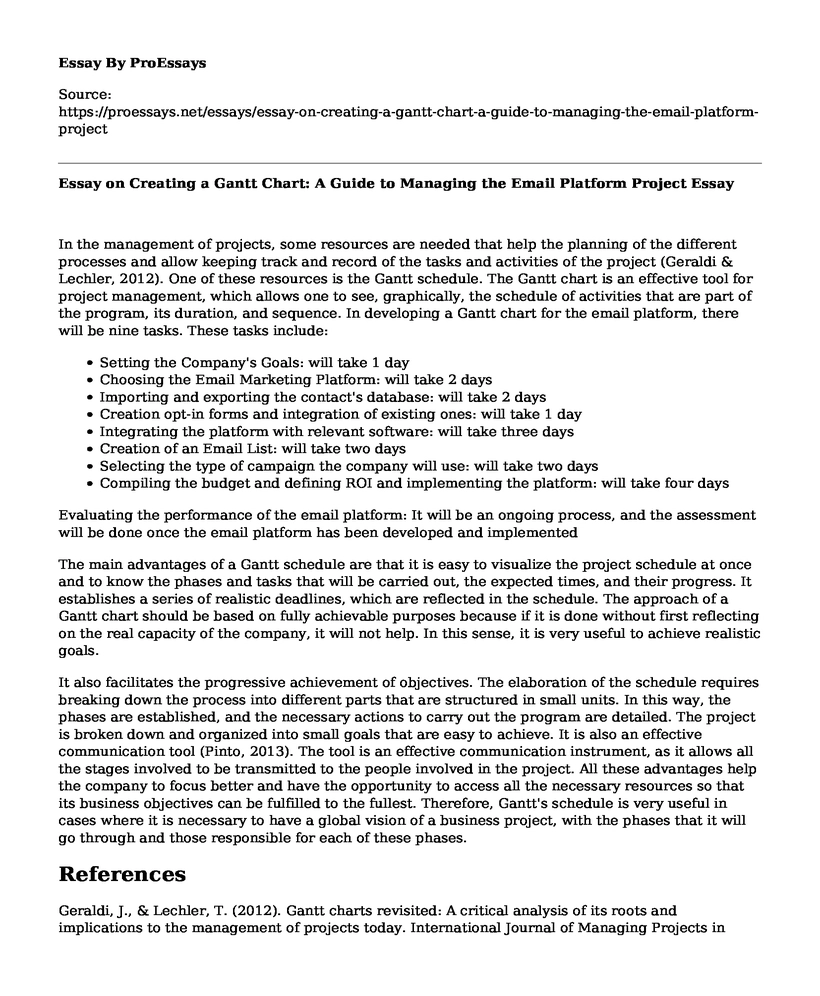In the management of projects, some resources are needed that help the planning of the different processes and allow keeping track and record of the tasks and activities of the project (Geraldi & Lechler, 2012). One of these resources is the Gantt schedule. The Gantt chart is an effective tool for project management, which allows one to see, graphically, the schedule of activities that are part of the program, its duration, and sequence. In developing a Gantt chart for the email platform, there will be nine tasks. These tasks include:
- Setting the Company's Goals: will take 1 day
- Choosing the Email Marketing Platform: will take 2 days
- Importing and exporting the contact's database: will take 2 days
- Creation opt-in forms and integration of existing ones: will take 1 day
- Integrating the platform with relevant software: will take three days
- Creation of an Email List: will take two days
- Selecting the type of campaign the company will use: will take two days
- Compiling the budget and defining ROI and implementing the platform: will take four days
Evaluating the performance of the email platform: It will be an ongoing process, and the assessment will be done once the email platform has been developed and implemented
The main advantages of a Gantt schedule are that it is easy to visualize the project schedule at once and to know the phases and tasks that will be carried out, the expected times, and their progress. It establishes a series of realistic deadlines, which are reflected in the schedule. The approach of a Gantt chart should be based on fully achievable purposes because if it is done without first reflecting on the real capacity of the company, it will not help. In this sense, it is very useful to achieve realistic goals.
It also facilitates the progressive achievement of objectives. The elaboration of the schedule requires breaking down the process into different parts that are structured in small units. In this way, the phases are established, and the necessary actions to carry out the program are detailed. The project is broken down and organized into small goals that are easy to achieve. It is also an effective communication tool (Pinto, 2013). The tool is an effective communication instrument, as it allows all the stages involved to be transmitted to the people involved in the project. All these advantages help the company to focus better and have the opportunity to access all the necessary resources so that its business objectives can be fulfilled to the fullest. Therefore, Gantt's schedule is very useful in cases where it is necessary to have a global vision of a business project, with the phases that it will go through and those responsible for each of these phases.
References
Geraldi, J., & Lechler, T. (2012). Gantt charts revisited: A critical analysis of its roots and implications to the management of projects today. International Journal of Managing Projects in Business, 5(4), 578-594. https://doi.org/10.1108/17538371211268889
Pinto, J. K. (2013). Project management: achieving competitive advantage (Fifth Edition). Upper Saddle River, NJ: Pearson. Retrieved from https://bookshelf.vitalsource.com/#/books/9780134730714/cfi/1!/4/[email protected]:51.5
Cite this page
Essay on Creating a Gantt Chart: A Guide to Managing the Email Platform Project. (2023, Mar 26). Retrieved from https://proessays.net/essays/essay-on-creating-a-gantt-chart-a-guide-to-managing-the-email-platform-project
If you are the original author of this essay and no longer wish to have it published on the ProEssays website, please click below to request its removal:
- Project Management Essay
- Project Management - Business School Construction
- Digital Culture Transformation Paper Example
- English Heritage Stakeholders Essay Example
- Strategic Positioning and Operational Effectiveness Paper Example
- Essay Example on HIWP: Addressing Human Resource Managers' Concerns
- Paper Example on CVS Health & Walgreens: Perfect Examples of Organizational Structure & Culture







